

Today, the country's third largest city, Mandalay, is the last royal capital of Myanmar built by King Mindon in 1857. Mandalay is also known as Yadanarbon Nay Pyi Taw (Gem City). It is the scene of incredible splendor and a wealth of religious buildings. It is situated on the eastern bank of the Ayeyawaddy River in Central Myanmar, 688 km north of Yangon. Mandalay is the cultural heart of Myanmar where the most refined arts, traditions of dance, music and drama live on.
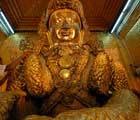
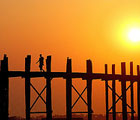
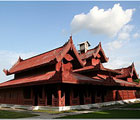


Getting To Mandalay
Accessibility
There are (7) domestic airlines operating daily between Yangon and Mandalay International Airport. It takes an hour by flights, about 12 hours by Express coaches and about 14 hours by rail from Yangon.
By Air (International)
China Eastern Airline, Air Asia
By Air (Domestic)
Myanmar Airwayss, Air Mandalay, Air Bagan, Air KBZ, Asian Wings, Yangon Airways, Golden Myanmar Airways
By Boat
From Bagan to Mandalay
Ma Li Kha Ship, Inland Water Transport Ship (Govt),
N Min Kha Ship, Pandaw, Road to Mandalay
From Mandalay to Bagan/Bha-mo
Pandaw, Road to Mandalay
Zone Fees
US$ 10 per person (Mandalay)
US$ 3 per person (Sagaing/Mingun)
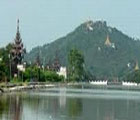
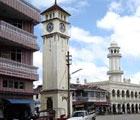
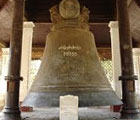
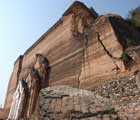
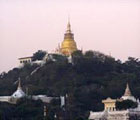
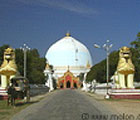
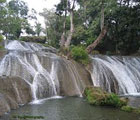
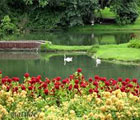
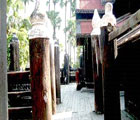
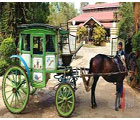
Atumashi Monastery
Atumashi Monastery is located at the north-eastern part of the Mandalay Palace. It is only about 10 minute drive from the Royal Palace. It was originally built in 1857 by King Mindon (1853-1879).
Kyauktawgyi Pagoda
The Kyauktawgyi Pagpda was built by King Bagan in 1847 on the model of the Ananda Temple in Bagan. It closely resembles the Ananda in exterior form but it falls short of the later in construction and interior decoration. There is one principal image carved out of a single block of Sagyin marble.
Maha Myat Muni Pagoda
Maha Myat Muni Pagoda is located southwest of Mandalay. The 4m high-seated Maha Myat Muni Pagoda Image, cast in bronze and weighting 6.5 tons has a crown which is decorated with diamonds, rubies and sapphires. The early morning ritual of washing the face of Buddha's image draws a daily crowd of devotees.
Mandalay Hill
To the north of downtown Mandalay is the well-known Mandalay Hill with a height of 230 m above sea level. The panoramic view of Mandalay City and the experience of sunrise or sunset are the greatest attractions for visitors to climb up the Mandalay Hill.
Mandalay Palace
The Royal Mandalay Palace is in the heart of Mandalay, between 12th street and 26th street. Mandalay Palace was the first Palace to be built in Mandalay, by King Mindon when he shifted his capital from Amarapura in 1861, which was to fulfil an old prophecy.
Mandalay Palace Moat and Wall
The whole palace complex was destroyed by fire during the Second World War. The palace walls, the four gates and the moats still stand today as evidence of the majestic palace city.
Snake Pagoda
It was built by King Min Shin Saw, in Palate region. Officially called Yadana Labamuni Hsutaungpye Paya. This Pagoda is generally known by another name: Mwe Paya, or the "Snake Pagoda" because the snakes are living there.
Taung Pyone
Taung Pyone village is located near Mandalay, the site where two brothers serving a king of Bagan in the 11th century were executed and they became powerful spirits or nats. To honour the Taung Pyone Brother Lords, tens thousands of Myanmar People hold the celebration annually.
Pone Ta Lote Lake
It is near Royal Palace in Mandalay. It is an artificial lake constructed by King Mindon in 1859. This lake was a recreational park for princes, princesses and royal families.
Stone Carving Workshops
The marble carving workshops are near Mahamuni Pagoda. Marbles are from the Sagin quarry about 35 miles (56km) north of Mandalay. Many religious items mainly Buddha images and stone slabs for inscription are produced. Other figures such as images of other religions, animal figures are also made by order.
Wood Carving Workshops
In Mandalay area, wood carving workshops produce many different figures and curving of ornamental and decorative flowers. The workshops are near the Mahamuni Pagoda and in Tampawaddy.
Bronze
Bronze casting workshops can be studied at a place called Tampawaddy between Mandalay and Amarapura. Buddha images, bells, gongs, tri gongs, and other figures such as images of the nats (spirits) and of famous persons are cast here.
Yandabo Pot Making Village
Yandabo is a village on the bank of the Ayeyawady River in Mandalay Region. It is famous for an Anglo-Myanmar peace treaty that was signed there in 1826. It is also a well-known place for making pots. One person can make 30 to 50 pots per day which are used for water or food storage.
Silk Weaving
Weaving industry is one of the main professions of the Amarapura people. Over one hundred looms are used to obtain beautiful and intricate design and patterns as silk are worn in very special and ceremonial occasion. As being a famous and interesting cottage industry, this is another place for visitors to have a look.
Mingun
Located about 11 km up river from Mandalay is Mingun on the western bank of the Ayeyawady River. Mingun is well-known for its huge 90-ton Mingun Bell, the world's largest uncracked and ringing bell.
Amarapura
Situated about 11 km south of Mandalay is Amarapura, an ancient city of Konbaung Dynasty. It is accessible by car from Mandalay. Its main attractions include the Pahtodawgyi Pagoda, U Bein Bridge and the silk weaving cottage industry. The famous U Bein bridge, 1208- metre long Teak bridge, spans the Taungthaman Lake.
Sagaing
Sagaing is situated on the western bank of the Ayeyawaddy River, 21 km southwest of Mandalay. The Sagaing Hills are best-known as a religious retreat and a centre for Buddhist studies and meditation. Kaungmudaw, an enormous dome-shaped Pagoda, Soon OOo Ponnya Shin Pagoda, Umin Thonzeh (thirty caves) Pagoda and Ywataung village, home of the silversmiths' guilds are also places of interest.
Pyin Oo Lwin
Pyin Oo Lwin is situated about 69 km up hill from Mandalay. It is over 1000 meter above sea level and has a delightfully cool and pleasant weather all year round. Well known for its colonial style houses and famous as a summer resort or a hill station, Pyin Oo Lwin attracts large numbers of visitors from all over the country during the summer. The other places of interest in the vicinity of the town are Pwekauk Waterfalls, Dat-taw-gyaint Waterfall, National Kandawgyi Garden, National LandMark, Butterfly Museum and Peik Chin Myaung Cave.
Dat-Taw-Gyaint Waterfall
The Dat-Taw-Gyaint Waterfall is located in Ani-sa-khan which is the half way point between Mandalay and Pyin-Oo-Lwin. The height of the waterfall is nearly 400ft (122 m) and the depth is about 300 ft (91 m).
Zegyo Market
Zegyo, the central market, is the heart of Mandalay where visitors can get practically everything made in Myanmar here, from everyday consumer goods to jewellery and fine fabrics. It is a perfect shopping place for souvenirs and local products.
The other shopping Centers are Diamond Plaza, 78 Shopping Center and Orange Super Market.
Golfing in Mandalay
The golf courses in Mandalay are Shwe Man Taung Golf Course (Mandalay Hill) 18 holes and Ye-ta-gun-taung Golf Course (12 km from Mandalay enroute to Pyin Oo Lwin) 18 holes.